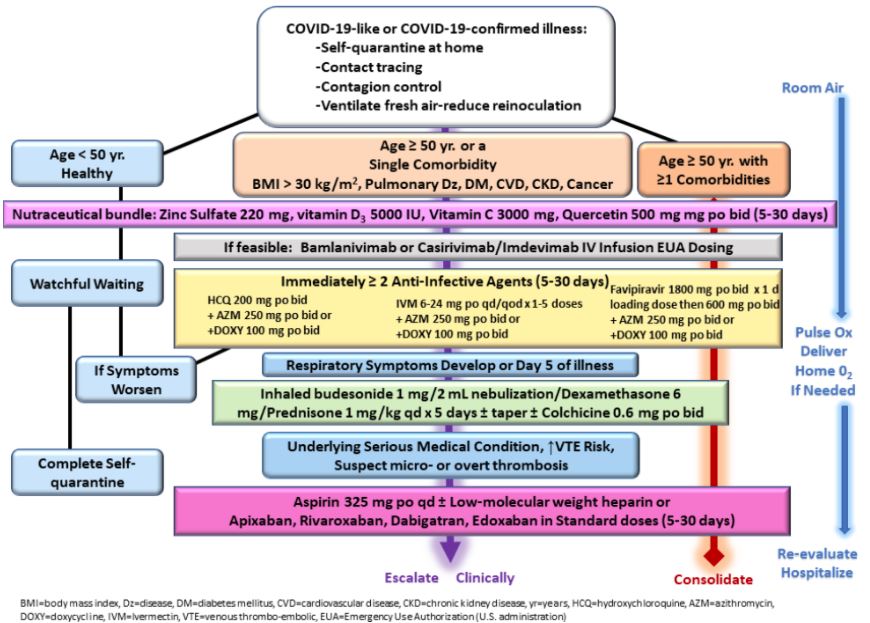A collaborative effort by 61 medical professionals and scientists, this article identifies existing treatment protocols for COVID-19, relevant studies with supporting evidence for the efficacy of protocol components (i.e., pharmaceuticals and supplements), and the therapeutic principles that should guide protocol development.
“Abstract and Figures: … In countries where therapeutic nihilism is prevalent, patients endure escalating symptoms and without early treatment can succumb to delayed in-hospital care and death. Prompt early initiation of sequenced multidrug therapy (SMDT) is a widely and currently available solution to stem the tide of hospitalizations and death. A multipronged therapeutic approach includes 1) adjuvant nutraceuticals, 2) combination intracellular anti-infective therapy, 3) inhaled/oral corticosteroids, 4) antiplatelet agents/anticoagulants, 5) supportive care including supplemental oxygen, monitoring, and telemedicine… An urgent immediate pivot from single drug to SMDT regimens should be employed as a critical strategy to deal with the large numbers of acute COVID-19 patients with the aim of reducing the intensity and duration of symptoms and avoiding hospitalization and death…
Fig. 3. Sequential multidrug treatment algorithm for ambulatory acute COVID-19 like and confirmed COVID-19 illness in patients in self-quarantine. Yr = year, BMI = body mass index, Dz = disease, DM = diabetes mellitus, CVD = cardiovascular disease, chronic kidney disease, HCQ =hydroxychloroquine, IVM = ivermectin, Mgt = management, Ox = oximetry, reproduced with permission from reference.

Introduction: Additionally, when feasible, prophylaxis could be viewed as an additional pillar since it works to reduce the spread as well as incidence of acute illness…
Our observations suggest a majority of hospitalizations could be avoided with a first treat-at-home strategy with appropriate telemedicine monitoring and access to oxygen and therapeutics…
In the absence of evidence from or a commitment to clinical trials of early therapy, other scientific information on the pathophysiology, treated natural history, and clinical judgement together must guide contemporary ambulatory management of COVID-19 (McCullough et al., 2020b). Observational studies reporting outcomes in patient populations managed consistently with empirically derived early intervention regimens currently provide an acceptable level of evidence for safety and efficacy of these widely available, inexpensive and safe alternatives to the current standard of non-intervention (Khan et al., 2020)…
Summary: … Precious time is squandered with a 'wait and see' approach in which there is no anti-viral treatment as the condition worsens, possibly resulting in unnecessary hospitalization, morbidity, and death. Once infected, the only means of preventing a hospitalization in a high-risk patient is to apply treatment before arrival of symptoms that prompt paramedic calls or emergency room visits. Given the current failure of government support for randomized clinical trials evaluating widely available, generic, inexpensive therapeutics, and the lack of instructive outpatient treatment guidelines (U.S., Canada, U.K., Western EU, Australia, some South American Countries), clinicians must act according to clinical judgement and in shared decision making with fully informed patients. Early SMDT developed empirically based upon pathophysiology and evidence from randomized data and the treated natural history of COVID-19 has demonstrated safety and efficacy. In newly diagnosed, high-risk, symptomatic patients with COVID-19, SMDT has a reasonable chance of therapeutic gain with an acceptable benefit-to-risk profile.”
This is an open access article under the CC BY 4.0 license (https://creativecommons.org/licenses/by/4.0/)
